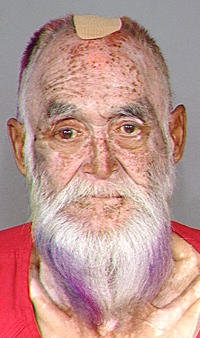AUGUSTA – DNA from a homeless Seattle man’s chewing gum helped lead authorities to arrest him in connection with an Augusta murder committed 36 years ago.
State and Augusta police arrested Gary Sanford Raub, 63, in Seattle on Monday night and charged him with the 1976 fatal stabbing of 70-year-old Blanche M. Kimball inside her State Street home.
The Kimball murder is the oldest unsolved homicide case in state history to result in charges, police said Tuesday.
Raub was known as Gary Robert Wilson at the time of the murder and lived at Kimball’s home. He is listed as a transient on the Kennebec County Superior Court complaint charging him with murder and criminal homicide in the first degree. The complaint says Raub “knowingly inflicted great physical suffering” on Kimball, a retired dental technician and practical nurse who occasionally took in boarders.
Raub — who in a police-provided photo has a large bandage on his head and a gray beard with purple streaks — is expected to make his first court appearance Wednesday, the first step in his extradition to Maine.
He was a suspect early in the case, but police didn’t have the evidence to charge him, according to court documents.
Lt. Christopher Coleman, commander of the Maine State Police Major Crimes Unit, said the investigation turned a corner in summer 2011 when police got a tip. Though the tip wasn’t helpful, the investigation that followed led to additional DNA analysis, and the murder charge against Raub.
Maine State Police Detective Abbe Chabot was assigned in 2003 as the primary investigator in the case.
Coleman wouldn’t say what Raub’s motive might have been. He said the two met when Raub rented a room at her house at 352 State St. There is now a parking lot where the house used to be. Kimball was never married and had no children, according to her obituary.
Police found Kimball’s body on June 12, 1976, after hearing from a neighbor who had not seen Kimball in several days.
Kimball’s clothing was pulled up and her body was decomposing, according to an affidavit Chabot filed in Kennebec County Superior Court.
Police theorized that Kimball was killed between June 2 and June 12, 1976, because they found a Kennebec Journal newspaper from June 2 at the scene as well as a receipt from Cottle’s supermarket dated June 5.
Henry Ryan, chief medical examiner at the time, counted “23 stab wounds to the chest, two stab wounds to the abdomen, 16 cuts and lacerations to the head, and three cuts and abrasions to the hands.” The cause of Kimball’s death was listed as stab wounds to the heart and numerous other cuts, along with hemorrhage and shock.
Investigators interviewed Raub twice shortly after Kimball’s death but he denied involvement. Coleman said Raub left Augusta shortly after the murder. Before he left, he was caught trying to break into a house near Kimball’s, police said.
Police interest in Raub rekindled after he was accused in an October 2011 stabbing in Seattle that injured another homeless man.
Chabot’s affidavit says blood collected from Kimball’s kitchen was tested for DNA earlier this year.
“It appeared that the person who had stabbed Blanche Kimball may have sustained injuries that caused him or her to bleed, leaving possible suspect blood on various items in the living room and kitchen,” Chabot wrote.
Investigators then collected a DNA sample from the knife used in the Seattle attack. The analysis showed partial profiles were linked to Raub and to the blood found in Kimball’s home.
An undercover officer with Seattle police then got a DNA profile from Raub in July by asking him to participate in a “chewing gum survey,” according to Chabot. Tests showed DNA from the gum was consistent with samples found in Kimball’s kitchen and on the knife handle from the Seattle stabbing.
Other DNA samples collected in the home matched samples connected to Raub.
Raub’s ethnicity is listed as caucasian/American Indian, and he told police he was from the Makah tribe, originally from a Neah Bay reservation in Washington. He was described as a heavy drinker in 1976.
Seattle writer Zachary Watterson interviewed Raub in December 2010 for a story about another homeless man, John T. Williams, who was shot by police. In the interview for The Stranger weekly newspaper, Raub said he was a Vietnam War veteran and had been a prisoner of war in Cambodia for three years. Raub said he had been homeless since returning from the war. Watterson said he never verified Raub’s claims.
Contacted by a reporter Tuesday, Watterson said he was surprised when he learned of Raub’s arrest.
“When you meet Gary, he comes across as a very easy-going, sweet, mild-tempered man,” Watterson said. “He was just coming back from Vietnam when the (Kimball) murder occurred. It’s hard to say what kind of condition he was in.”
The Maine State Police’s listing of unsolved homicides includes more than 60 murders; the oldest is the 1970 killing of Mary C. Olenchuk in Ogunquit.
Jared Mills, deputy chief of the Augusta Police, which worked with Maine State Police throughout the 36-year investigation, said the charges prove the effort was worthwhile.
“The public needs to know these cases never go away,” Mills said.
Kennebec Journal Staff Writer Betty Adams can be contacted at 621-5631 or:
badams@centralmaine.com
Send questions/comments to the editors.






